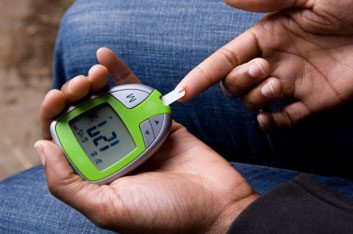
Keeping tabs on your blood sugar
If you’re not taking insulin, should you be testing your blood glucose during your day? The short answer is yes. You may not be using the results to adjust an insulin dose or the dinner menu, but it’s still important for people with Type 2 diabetes to be aware of their levels. “If there’s no testing, your sugars can be out of whack,” says Tabitha Palmer, a dietitian and certified diabetes educator working in Endocrinology Research at Capital Health in Halifax. “You can feel just fine with high blood sugar, but unfortunately they can still be causing all sorts of problems inside.”
You certainly don’t need to test as often as someone with Type 1 diabetes would. But it may be a good idea to check your blood glucose level once or twice during the day.

Taking medication
Not everyone with Type 2 diabetes takes medication. But if you do, part of your day involves taking your pills or administering your injections. The medication may be prescribed to lower blood sugar, help your body produce insulin or provide the insulin your body can’t produce.
About a quarter of people with Type 2 diabetes will eventually need to have insulin injections. “It’s not something that’s considered a failure or your fault. It’s just a natural progression of the disease,” says Palmer. These days, people are being diagnosed with Type 2 diabetes at a much younger age, which means they could be living with the disease for decades.

Watching your diet
If you have Type 2 diabetes, your daily routine should always include three healthy meals. It’s important to put some planning into what goes on your plate. Because you’re at a high risk for cardiovascular problems, such as heart disease and stroke, your focus should be on low-fat foods.
There are other bonuses: A low-fat diet will help you shed a few pounds. Losing weight may even reduce your need for medication.

Staying active
Exercise, like healthy eating, will help reduce your cardiovascular risk, and help you manage your blood sugar levels and weight. A typical day in the life of someone with Type 2 diabetes should include some physical activity like aerobic exercise or stretching. Even just choosing the stairs, or walking to your co-worker’s cubicle instead of sending her an email, will make a difference.
Depending on the medication you take, you may experience blood sugar lows while you exercise, so carry sugar tablets or candies just in case. Drinking water before and during your activity can also help stabilize your sugar levels.

When you’re on the go
Many people with Type 2 diabetes are on the go: They’re travelling, whether it’s for business or pleasure. If your day involves catching a flight, be sure to bring all the supplies you’ll need while you’re away, such as medication or test strips. “I usually recommend taking twice as much as you need,” says Palmer. “Take them with your carry-on, so if your luggage gets lost, [you’ll still have] your medication and testing supplies.” An ice pack or small cooler will help keep your insulin cool.
It’s also a good idea to bring extra prescriptions in case your medication needs replacing or refilling. Some people with diabetes carry a doctor’s note to offset any problems travelling with syringes.

Coping while sick
No one plans to be under the weather. But there may be a day when a cold or flu virus knocks you flat. You may be feeling lousy, but you mustn’t cut back on your medication. Your blood glucose level is likely already high if you’re sick, and skipping your pills will push it even higher. Also, even if your appetite is a no-show, you should still try to swallow a few crackers or a gelatin dessert, and drink lots of water.

It’s all about choices
When you’re living with Type 2 diabetes, it affects many of your daily decisions. But with the right choices, your disease will stay under control. “Healthy eating and exercise are the cornerstones here,” says Palmer. These strategies will help you stabilize your blood sugars, maintain your ideal weight, reduce your risk of complications-and get on with your life.
Related:
• NEW! 2-Day Diabetes Diet
• 19 tips for stable, steady blood sugar levels
• 13 tips for eating out if you have diabetes
